Art World
How the Dana Schutz Controversy—and a Year of Reckoning—Have Changed Museums Forever
Glenn Lowry, Adam Weinberg, and other museum leaders describe how a year of protest changed the way they view their institutions' roles
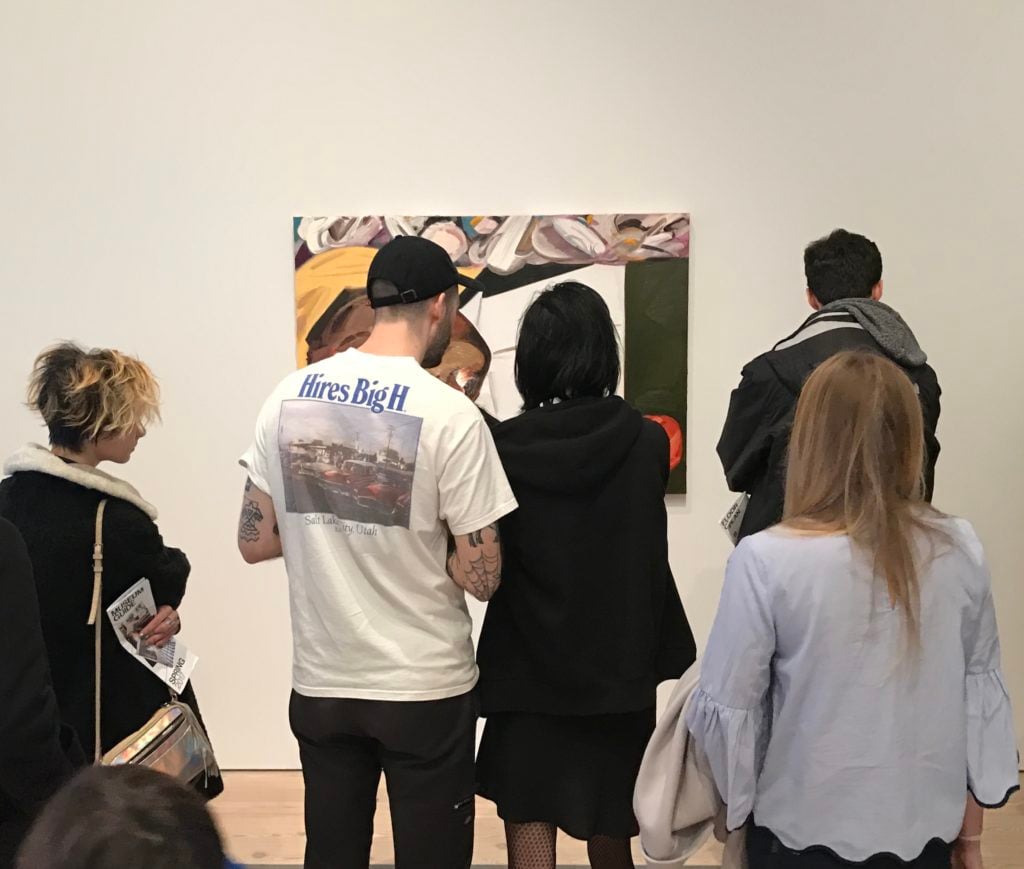
Glenn Lowry, Adam Weinberg, and other museum leaders describe how a year of protest changed the way they view their institutions' roles

Julia Halperin

Last March, the artist Parker Bright stood in front of Dana Schutz’s painting Open Casket at the Whitney Biennial wearing a t-shirt with the words “Black Death Spectacle” scrawled in Sharpie across the back. Photos of his protest went viral on social media, and it set off a chain of events that put the Whitney at the center of a scorched-earth debate over cultural appropriation, the definition of censorship, and the very role of the contemporary art institution in the Trump era. Now—almost one year later—some say museums will never be the same.
The Whitney is one of a number of institutions, including the Walker Art Center in Minneapolis and the Contemporary Art Museum, St. Louis, that have found themselves in the crossfire for presenting art that some have deemed insensitive, exploitative, or even traumatizing.
These bitter conversations about the need for change have been echoing across the culture field. Their contentions were, for instance, front and center at the 90th Academy Awards on Sunday night, while New York magazine recently dubbed 2017 “The Great Awokening” in pop culture. And while museums have long faced criticism of various kinds, many of the field’s top cultural leaders say that a potent cocktail of factors—from the fraught political situation in the US to the magnifying powers of social media—have caused these recent protests to erupt with unprecedented force, leading to a deeper rethinking.
“We’re in a time when these issues are real, these controversies are part of public space and public discourse, and museums are going to become places where these issues get played out,” Glenn Lowry, the director of the Museum of Modern Art in New York, told artnet News.
For some institutions—particularly those engulfed by controversy—this period of tumult has resulted in concrete changes to policy and governance. For those museums watching from the sidelines, the desire to avoid becoming the next target of social-media outrage has been a powerful motivator to diversify their curatorial staffs and to rethink the way they message their core values.
And while some institutions are implementing more fundamental changes than others, almost all of the dozen museum directors and curators we spoke to for this story agreed on one thing: For the first time since the Culture Wars in the 1980s and ‘90s, they need to be prepared to defend every single decision they make.
“I think it’s a sea change,” Lisa Melandri, the director of CAM St. Louis, told artnet News. Her museum came under fire in late 2016 for mounting an exhibition of work by the white artist Kelley Walker that included images of black Americans smeared with toothpaste, chocolate, and milk. The recent spate of controversies, she said, “has changed the way all of us in this field make exhibitions.”
In the months after the Walker exhibition, Melandri says, CAM St. Louis had to work to regain the trust of its audience—and of its own staff, some of whom joined with protesters in calling for the offending works to be removed.
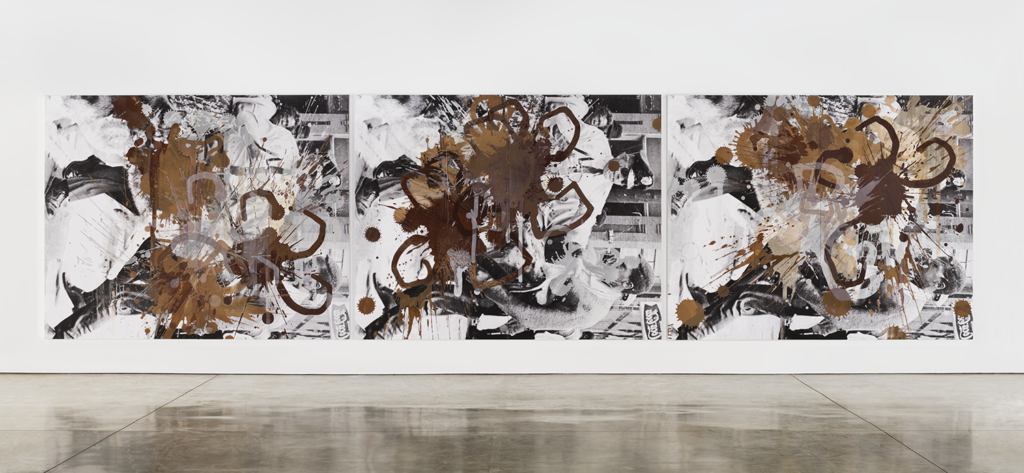
Kelley Walker, Black Star Press (rotated 90 degrees), 2006. Courtesy the artist; Paula Cooper Gallery, New York; Thomas Dane Gallery, London; and Galerie Gisela Capitain, Cologne.
The museum has now developed a formal process to reach out to groups that might be sensitive to the contents of an upcoming show. For example, around four months ahead of the opening of its survey of Hayv Kahraman, an Iraqi artist who makes work about her experience as an immigrant, curators got in touch with local immigration resettlement and advocacy groups; eventually, they sent them the show’s entire checklist.
The museum has also extended the planning phase for exhibitions so that every department—including those that deal most directly with the public—can be involved in preliminary conversations. (Notably, the three nonwhite staff members who protested the Walker show were not part of the curatorial staff, and therefore not involved in these early discussions. All three have since left the museum; Melandri noted that their replacements are also people of color.)
This new process is far from perfect. Many curators aren’t used to incorporating feedback from their constituents in real time. “What if we had said, ‘Here is our Kelley Walker show,’ and we put an advisory board together, but it was already scheduled?” Melandri asked. “Do you remove things from the checklist? Do you not do the show? How much input do you get from various communities and when? When is too soon to ask, and when is too late?”
She and colleagues from other museums recently found themselves talking about how helpful it would be to have a guidebook for how to respond to controversies. “What would it be like to have a controversy hotline?” she asked. “Who do you reach out to—legal, human resources? When do you call the chair of your board?” The answers are far from clear.
CAM St. Louis isn’t the only institution making changes in the wake of controversy. The Walker Art Center in Minneapolis, for instance, recently established a Native American advisory group that will help select a Native American artist to create a significant new commission for the museum.
The work, likely destined for the Walker’s sculpture garden, aims to repair the breach caused by Sam Durant’s Scaffold, which drew ire from local Native American leaders because of its reference to the mass execution of 38 Dakota Indians in nearby Mankato, Minnesota. Last summer, the artist and the museum agreed to hand the work over to local Dakota leaders, who ceremonially buried it.
“There are a lot of things that we are doing internally to look at some of our blind spots and change our internal culture and working processes,” said Siri Engberg, the visual arts curator at the Walker.

Sam Durant, Scaffold. Courtesy of Sarah Cascone.
For one thing, the museum has tweaked its approach to evaluating acquisitions in order to make sure that its committee considers both how the work fits into the Walker’s long-term acquisitions strategy and how it might be received locally. (Scaffold, which first appeared in documenta 13, was acquired in 2014; the museum did not consult local Native American leaders beforehand.)
The Walker is also working to develop a new protocol for placing art in public spaces, which Engberg notes may require beefing up educational programming, wall labels, and other interpretive material. “We need additional time and additional voices at the table when putting art in a public space,” she said.
The process has been painful—and, some say, led to the departure of Olga Viso, the museum’s director, who resigned in November. Engberg is part of the newly established Office of the Executive Director, which is leading the museum as it searches for a replacement. She declined to comment on Viso’s departure, beyond noting that she left after successfully completing a major capital campaign and renovation.
“I think museum directors are in a moment right now where there is a lot of taking stock, looking forward, looking within,” Engberg said. “It’s not a time of easy answers.”
Experts say that a combustible mix of factors have made museums more prominent targets for protest and controversy than ever before.
First, their hard-won popularity and increasing approachability has empowered a broader swath of the public to criticize them. “When I was younger, museums were these sacred spaces—you thought they had the last word on everything,” said Herb Tam, the curator of New York’s Museum of Chinese in America. “Now, museums are so popular, so populist. They fit into our daily lives in a different way.”
Furthermore, a new generation of cultural consumers has “new demands and new questions,” said Helen Molesworth, the chief curator at the Museum of Contemporary Art, Los Angeles. “Museums writ large are playing catch up.”
This younger audience is forcing institutions to “reckon with the fact that symbolic representation isn’t good enough,” noted Amy Sadao, the director of the Institute of Contemporary Art Philadelphia, who attributes her own career to protests in the ’90s that raised awareness about the lack of Asian American artists in the Whitney Biennial.
Some museum leaders blame today’s heated political climate for boiling over into crises in the culture sector. “Since the presidential election, I think everybody’s emotions are just exceptionally raw,” Glenn Lowry said. “Issues that might otherwise have been resolved through debate and discussion flare up into controversies very quickly.”
Despite directors and curators’ newfound introspection, however, many maintain that the calls to destroy offending works, like Dana Schutz’s painting, were out of bounds. “When people are threatening with violence and destruction, it crosses a different line,” said Adam Weinberg, the Whitney’s director.
Nevertheless, he noted that in some ways, the swirl of controversy around museums follows a familiar pattern. Institutions have historically been subject to vigorous critique during moments of social and political upheaval, like the Civil Rights Movement and the Vietnam War. “It’s about a contest of ideas—and this is where ideas are displayed and contested and seen, and it’s also, to a degree, safe territory,” Weinberg said. “It’s a place where conversations can happen.”
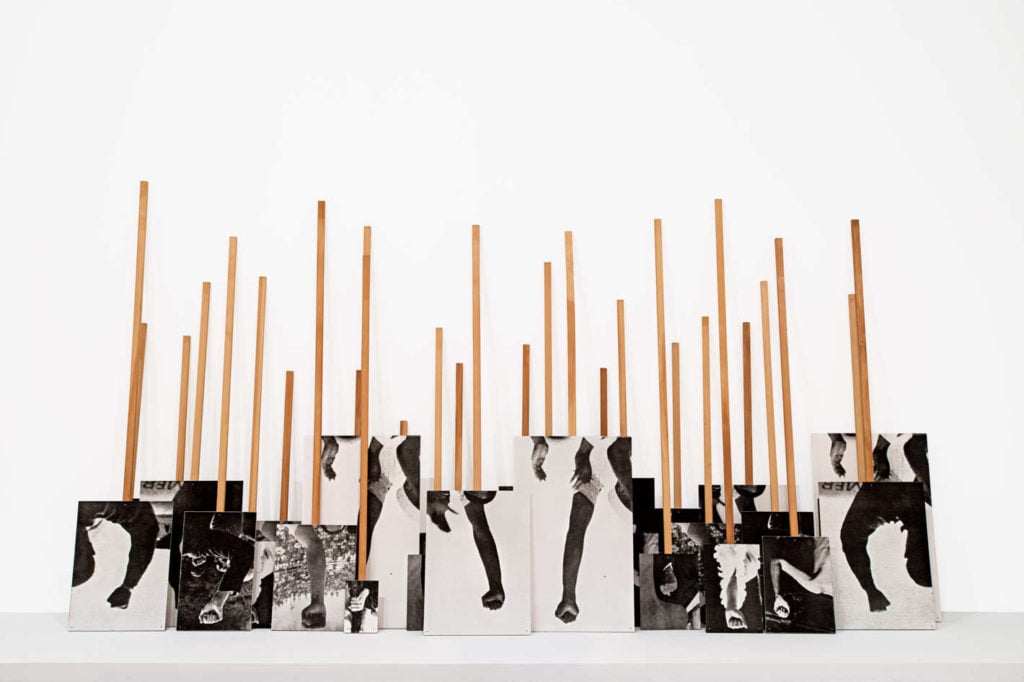
Annette Lemieux’s Left Right Left Right (1995); upside down at the Whitney Museum after Trump’s election. Courtesy of the Whitney and the artist.
The Whitney has not made the kind of structural changes that the Walker or CAM St. Louis have (in part, Weinberg said, because the museum has always consulted community groups about major initiatives). But the experience has emboldened staff to confront sensitive issues, like those surrounding the artist Jimmie Durham’s native identity or the museum’s own history as the subject of protest, head-on in exhibitions.
On a public tour of the Durham show in December, the questions that had raged around the artist’s identity were not glossed over but instead placed at the forefront. A guide laid out both sides of the debate within the first 10 minutes, went to great pains to explain why the stakes were so high (“This is a really big deal,” she said), and invited visitors to participate in a moderated conversation after the tour about “the ethics of looking.” A note from Weinberg addressing the issue has also been posted on the museum’s website.
One major difference stands out between the Vietnam-era protests and those of today: During the late ’60s, nobody had access to Twitter or Facebook, meaning the opposition was typically gradual in taking shape and highly local. Now, it can become global—fast.
Some worry that, in the current climate, museum face pressure to respond to controversy quickly rather than thoughtfully.
“The concern is the gang mentality,” said Anne Pasternak, the director of the Brooklyn Museum. “People can say anything on social media without first having facts or being in conversation. I get it, but I find it very problematic. My concern is that institutions will consciously or subconsciously choose to retreat from important conversations because if you slip up in the slightest, the mob mentality can be so vicious, and people lose their jobs over it.”
One noted artist, who asked to remain anonymous, told artnet News that she was asked to modify a proposal for a major American art festival because the organizers worried it might be poorly received in the wake of recent controversies.
Her proposal originally involved presenting work across two sites: the local art museum in an upscale, predominantly white neighborhood and another site in a lower-income, predominantly African American neighborhood. Organizers asked her to limit the project to the museum because “they did not have enough budget on the educational side of it to explain the project properly,” the artist said. Now, she and the festival’s organizers are working together to try to relocate the second part of the project to a third site: a public housing development with a diverse population of residents. She said the organizers believe it has less potential for controversy.
This chilling effect this produces has not been lost on museum directors themselves. “The anxiety that we all have is that our institutions might at some point get gun shy of very difficult work because of a fear of the consequence,” Lowry said.
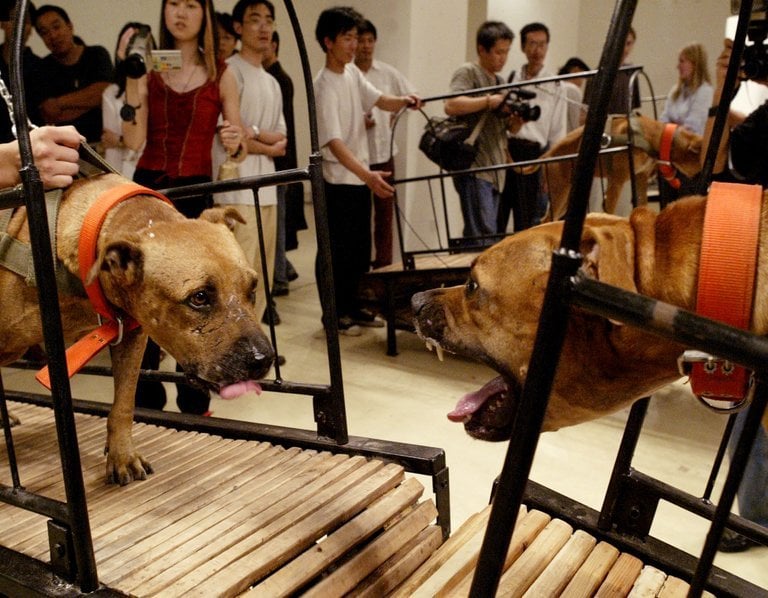
Sun Yuan and Peng Yu’, Dogs That Cannot Touch Each Other. The Guggenheim removed the video, which features eight pit bulls on treadmills, from an upcoming exhibition. Courtesy of Galleria Continua, San Gimignano, Beijing, Les Moulins, Habana.
Though they stemmed from very different sensitivities, at least two other major controversies last year led museums to remove work from view after facing the threat of violence. Last February, the Museum of the Moving Image in Queens had to abort a participatory anti-Trump internet project after it became a real-world gathering point for alt-right protesters. In September, the Guggenheim removed several artworks involving animals from its show “Art and China after 1989: Theater of the World” following an online campaign and threats against staff.
Nevertheless, there are some who maintain that the fear of outright censorship is overblown—after all, those protesting almost always have less power than the institutions themselves. And self-censorship, they note, isn’t always a bad thing.
This series of controversies has taught the field that “if you don’t have your ducks in a row, you aren’t ready,” said Helen Molesworth. “So the question is, how do you get ready? How do you make sure that what you are doing is thoughtful and is not partaking in some old, deep, white supremacist, colonialist tradition of art as missionary?”
If the controversies of 2017 convinced museums of one thing, it is perhaps that the time is long overdue to make their networks, staffs, and boards more diverse. “You need to have a brain trust that feels empowered to tell you, ‘This is problematic,’” Amy Sadao said.
Over the past year, the Whitney has added three women of color to its curatorial staff (one of whom, Rujeko Hockley, will also co-organize the 2019 biennial). Weinberg said that the museum was pushing to expand its ranks well before the Schutz controversy, but the experience “absolutely” encouraged it to redouble its efforts. CAM St. Louis has made two curatorial hires since 2016, both of whom are women of color.
Still, some say museums must go further. “Diversity is not enough,” Pasternak said. “We had to break down silos between departments, between expertise.” She noted that without a diverse staff and board, the Brooklyn Museum would not have been comfortable producing its well-reviewed “Legacy of Lynching” show in just five weeks last summer, for fear that African American communities “would feel traumatized by the content.” But the show was immeasurably enriched by the public programs, education, and community outreach teams, who encouraged Pasternak to add an empty room where visitors could process and leave comments about what they’d seen.
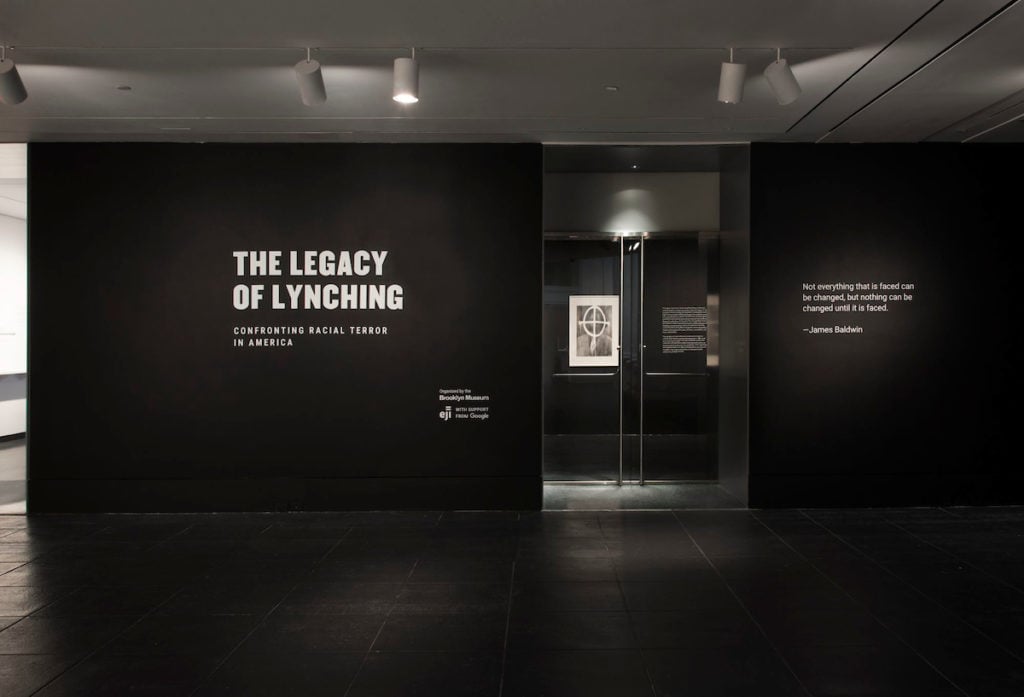
Installation view of “The Legacy of Lynching: Confronting Racial Terror in America” at the Brooklyn Museum. Photo by Jonathan Dorado.
“I wasn’t a fan [of the idea], but they pushed back, and I’m glad they did,” she said. The comments became one of the most moving parts of the show, and are now destined for the archive at the Equal Justice Initiative’s forthcoming Legacy Museum.
Undeniably, last year’s controversies generated a lot of conversation—and intense soul-searching on the part of museum leaders. But will anything truly, deeply change as a result?
Some believe that cosmetic tweaks to organizational structure and community outreach won’t do it. After all, they say, museums are inherently elitist and often funded by the people who benefit most from existing power structures. And most curators spend more time fundraising than interacting with their audiences directly.
“As long as museums continue on this path of being spaces of entitlement and privilege, they are going to be targets,” said the writer and curator Claire Barliant, who organized a well-reviewed 2014 exhibition about identity politics and political correctness in art.
But others maintain that museums are finally being forced to ask themselves questions that they have ignored for decades—and that is no small reckoning. “What we are learning slowly and painfully is, in a sense, a much more sophisticated set of manners and empathy,” Helen Molesworth said. “You really have to think to yourself, ‘How will this feel to other people?’ White people are really not used to thinking that.”
“I feel we are different institutions across the field now than we were a couple of years ago,” Melandri said. “And that is a great, valuable thing.”